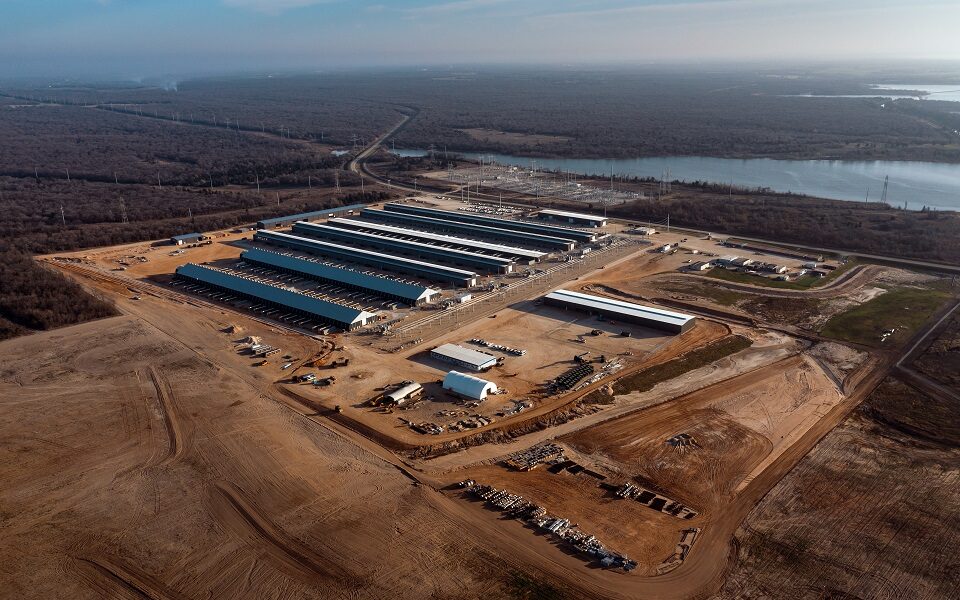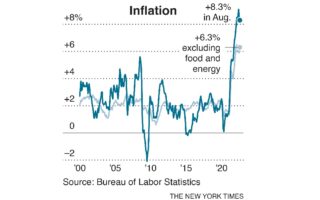The real-world costs of the digital race for bitcoin

Texas was gasping for electricity. Winter Storm Uri had knocked out power plants across the state, leaving tens of thousands of homes in icy darkness. By the end of February 14, 2021, nearly 40 people had died, some from the freezing cold.
Meanwhile, in the husk of a onetime aluminum smelting plant an hour outside of Austin, row upon row of computers were using enough electricity to power about 6,500 homes as they raced to earn bitcoin, the world’s largest cryptocurrency.
The computers were performing trillions of calculations per second, hunting for an elusive combination of numbers that bitcoin’s algorithm would accept. About every 10 minutes, a computer somewhere guesses correctly and wins a small number of bitcoins worth, in recent weeks, about $170,000.
In Texas, the computers kept running until just after midnight. Then the state’s power grid operator ordered them shut off, under an agreement that allowed it to do so if the system was about to fail. In return, it began paying the bitcoin company, Bitdeer, an average of $175,000 an hour to keep the computers offline. Over the next four days, Bitdeer would make more than $18 million for not operating, from fees ultimately paid by Texans who had endured the storm.
The New York Times has identified 34 such large-scale operations, known as bitcoin mines, in the United States, all putting immense pressure on the power grid and most finding novel ways to profit from doing so. Their operations can create costs – including higher electricity bills and enormous carbon pollution – for everyone around them.
Until June 2021, most bitcoin mining was in China. Then it drove out bitcoin operations, at least for a time, citing their power use among other reasons. The United States quickly became the industry’s global leader.
Since then, precisely how much electricity bitcoin mines are using in America and their effect on energy markets and the environment have been unclear. The Times, using both public and confidential records as well as the results of studies it commissioned, put the most comprehensive estimates to date on the largest operations’ power use and the ripple effects of their voracious demand.
In some areas, this has led prices to surge. In Texas, where 10 of the 34 mines are connected to the state’s grid, the increased demand has caused electric bills for power customers to rise nearly 5%, or $1.8 billion per year, according to a simulation performed for the Times by energy research and consulting firm Wood Mackenzie.
The additional power use across the country also causes as much carbon pollution as adding 3.5 million gas-powered cars to America’s roads, according to an analysis by WattTime, a nonprofit tech company. Many of the bitcoin operations promote themselves as environmentally friendly and set up in areas rich with renewable energy, but their power needs are far too great to be satisfied by those sources alone. As a result, they have become a boon for the fossil fuel industry: WattTime found that coal and natural gas plants kick in to meet 85% of the demand these bitcoin operations add to their grids.
Their massive energy consumption combined with their ability to shut off almost instantly allows some companies to save money and make money by deftly pulling the levers of U.S. power markets. They can avoid fees charged during peak demand, resell their electricity at a premium when prices spike and even be paid for offering to turn off.
In some states, bitcoin operators’ revenue can ultimately come from other power customers. The clearest example is Texas, where bitcoin companies are paid by the grid operator for promising to quickly power down if necessary to prevent blackouts. In practice, they rarely are asked to shut down and instead earn additional money while doing exactly what they would have been doing anyway: seeking bitcoin.
Several of the companies are being paid through these agreements a majority of the time they operate.
In interviews and statements, many of the companies said they were no different from other large power users except for their willingness to shut off quickly to benefit the grid. Several objected to the method the Times and WattTime used to estimate their emissions, which calculated the pollution caused by the additional power generated to satisfy the mines’ demand, showing it to overwhelmingly come from fossil fuels.
The companies said this method held them to an unfair standard.
“The analysis cited could be used to attack any industry that consumes power,” said David Fogel, CEO of Coinmint, which operates in upstate New York. “I think the entire notion of singling out specific industries like this is unfair.”
Many academics who study the energy industry said bitcoin mining was undoubtedly having significant environmental effects.
“They’re adding hundreds of megawatts of new demand when we already face the need to rapidly cut fossil power,” said Jesse Jenkins, a Princeton professor who studies electrical grid emissions.
“If you care about climate change,” he added, “then that’s a problem.”
Lee Bratcher, president of the Texas Blockchain Council, a bitcoin lobbying group, said in an email that the industry incentivizes the development of new renewable and natural gas plants. But power industry experts say that although some current wind farms may be benefiting modestly, renewable generation takes years to build and usually requires commitments from customers who can guarantee that they will buy power for a decade or more.
According to Jenkins, the bitcoin operations’ near-constant power demand is more likely to keep fossil fuel plants in business than to lead to more renewable energy.
Some of the bitcoin companies that WattTime found to be causing the most pollution have held themselves out as supporting renewables.
For example, Riot Platforms’ CEO described bitcoin mining as “uniquely beneficial and supportive of renewable energy.” Ninety-six percent of the power demand added by the company’s mine was met by fossil fuels, the WattTime analysis showed.
Bitcoin miners’ power play
Mining bitcoin produces steady revenue, but using so much electricity can also be a business model.
Moments of extreme weather provide especially stark examples. Take June 23, 2022 – the eighth-straight day of near-100-degree temperatures around Austin, which allowed Riot Platforms to demonstrate several ways they can turn electricity into money.
Like many industrial buyers, the company had prepurchased its power at a fraction of the price available to residential customers. Riot’s mine runs at 450 megawatts – the largest in the country.
Each day that June, its computers’ guesses were winning bitcoin worth an average of about $342,000. But the company had two additional ways to improve its profit margins.
First, it had signed up for the Responsive Reserve Service, a Texas power grid program that offers a way to quickly reduce strain if the grid becomes overloaded, acting as insurance against blackouts. The program pays miners, and other companies, for promising to stop using electricity upon request. In reality, they are rarely asked to shut down but are still paid for making the pledge.
From midnight to nearly 4 p.m. on June 23, Riot earned more than $42,000 from the program while continuing to mine bitcoin.
About that time, the company switched to the second technique: avoiding fees that Texas charges to maintain and strengthen the power grid. It did so by briefly shutting off almost completely.
By 6:30 p.m., the company had resumed mining. If Riot had been fully operating all day, it would have incurred an estimated $5.5 million in fees – costs that are largely made up by other Texans. Over the course of the year, this saved Riot more than $27 million in potential fees.
The company’s actions were described in data published by the Texas grid operator, the Electric Reliability Council of Texas, or ERCOT. Although the records refer to power suppliers by pseudonyms, the Times was able to identify six of the 10 Texas operations in the data.
One final mechanism lets some companies make extra money when electricity prices spike: They can stop mining and resell electricity to other customers. That earned Riot roughly $18 million last year.
From bitcoin mining, the company earned $156.9 million last year.
After accounting for the savings and revenue from each of the strategies, Riot told investors that its electricity cost in 2022 was 2.96 cents per kilowatt-hour.
By comparison, the average price for other industrial businesses in Texas was 7.2 cents. For residents, it was 13.5 cents.
‘Texas will be the crypto leader’
These opportunities have led some of the country’s largest bitcoin operations to choose Texas.
“It’s a massive financial burden to Texans,” said Ben Hertz-Shargel, who leads grid-related research at Wood Mackenzie, and was part of the team that conducted the market-based simulation for the Times based on historical ERCOT data. Because of how the Texas market operates, the increases are steepest for residential customers, said Hertz-Shargel.
Others say increased prices will incentivize the development of cheaper types of power generation.
In Texas, the companies have powerful allies. Gov. Greg Abbott said in a tweet that “Texas will be the crypto leader” and hosted the Texas Blockchain Council at the governor’s mansion. The grid’s former interim CEO declared himself “pro bitcoin,” and the current vice chair of the grid’s board is a former adviser to the Texas Blockchain Council. Still, in March, three Republican state senators joined in sponsoring a bill that would restrict tax breaks for miners and place strict limits on their participation in programs such as the Responsive Reserve.
In Rockdale, where two of the largest mines in the country operate just outside the city limits, the city manager, Barbara Holly, told the Times that the town used to be “a fairly wealthy little community.” She said that changed when a large industrial plant that had provided thousands of jobs closed more than a decade ago. “It just cut the legs out from under this community,” she said.
It was the old aluminum smelter, now home to the Bitdeer mine.
This article originally appeared in The New York Times.






